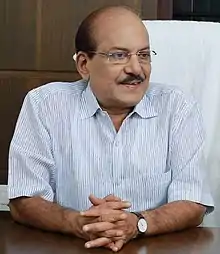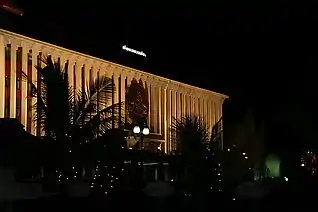Politics of Kerala
Kerala is an Indian state, where federal legislative power is vested in the unicameral Kerala Legislative Assembly. The multilateral system has, since 1956, been dominated by the several pre-poll and post-poll alliances.
 Coat of arms of Kerala | |
| Polity type | Democratic |
|---|---|
| Constitution | Constitution of India |
| Formation | 1950 |
| Legislative branch | |
| Name | Kerala Legislative Assembly |
| Type | Unicameral |
| Meeting place | Assembly Building |
| Presiding officer | P. Sreeramakrishnan, Speaker |
| Executive branch | |
| Head of State | |
| Title | Governor |
| Currently | Arif Mohammad Khan |
| Head of Government | |
| Title | Chief Minister |
| Currently | Pinarayi Vijayan |
| Appointer | Governor |
| Cabinet | |
| Name | Cabinet of Kerala |
| Current cabinet | Cabinet Vijayan |
| Leader | Chief Minister |
| Appointer | Governor |
| Judicial branch | |
| Name | Judiciary of India |
| Kerala High Court | |
| Chief judge | S. Manikumar |
| Seat | Kochi |
The judiciary of Kerala is independent of the executive and the legislature, while it is common for leading members of the executive (Kerala Council of Ministers) to be members of the legislature as well. The political system is laid out in the Constitution of India (1950).
Legislative Assembly has a membership of 141, where 140 are elected and one is nominated from the Anglo-Indian community. Kerala has 20 seats in the Lok Sabha (Indian Lower House) and nine seats in the Rajya Sabha (the Council of States). Elections are also held to choose representatives to the civic bodies at various levels within Kerala.
Political parties
National parties
| Sl No | Party Name | Symbol Name |
|---|---|---|
| 1 | Bahujan Samaj Party | Elephant |
| 2 | Bharatiya Janata Party | Lotus |
| 3 | Communist Party of India | Ears of Corn and Sickle |
| 4 | Communist Party of India (Marxist) | Hammer, Sickle and Star |
| 5 | Indian National Congress | Hand |
Recognised State Parties
| Sl No | Party Name | Symbol Name |
|---|---|---|
| 1 | Indian Union Muslim League | Ladder |
| 2 | Janata Dal (Secular) | A Lady Farmer Carrying Paddy on her Head |
| 3 | Kerala Congress (Mani) | Two Leaves |
| 4 | Revolutionary Socialist Party | Spade and Stoker |
Popular vote

| 1957 Assembly elections | 2016 Assembly elections | ||
|---|---|---|---|
| Parties | Popular vote % | Parties | Popular vote % |
| Indian National Congress (INC) | 37.84 | Communist Party of India Marxist (CPIM) | 26.7 |
| Communist Party of India (CPI) | 35.28 | Indian National Congress (INC) | 23.8 |
| Praja Socialist Party (PSP) | 10.76 | Bharatiya Janata Party (BJP) | 10.6 |
| Revolutionary Socialist Party (RSP) | 3.22 | Communist Party of India (CPI) | 8.2 |
| Indian Union Muslim League (IUML) | 7.4 | ||
| Kerala Congress (Mani) (KCM) | 4.0 | ||
Ideologies

Left or centre-left politics
The social thought and behavior of the people of Kerala in general has a strong inclination towards left or centre-left politics and thus the communist parties (the Communist Party of India or the Communist Party of India Marxist) have made strong inroads in Kerala.[1] Kerala was the first Indian state where the communists (Communist Party of India) were voted to power.[1]
The northern Kerala, particularly Kannur, and Palakkad in central Kerala are generally considered to be the heartland for communist support. The Kollam and Alapuzha districts are also generally inclined towards the left or centre-left parties; though the United Democratic Front have won elections from the constituencies of these districts several times.[1]
Congress politics
Indian National Congress leads the United Democratic Front pre-poll alliance in Kerala. The alliance was created by the Congress (then known as Congress-Indira) party leader K. Karunakaran in 1978.[2] Since the 1980s, it has sustained itself as the front to take on the Communist Party of India Marxist-led Left Democratic Front.
The alliance first came into power in Kerala in 1981 under K. Karunakaran. It led the Kerala government in 1981 - 82 (Karunakaran), 1982 - 87 (Karunakaran), 1991 - 96 (Karunakaran and A. K. Antony), 2001 - 06 (Antony and Oommen Chandy) and 2011 - 16 (Chandy).
The party has strong bases in Ernakulam and Kottayam regions of central Kerala.
Communitarian politics
Indian Union Muslim League is a major member of the United Democratic Front. Indian Union Muslim League first gained a ministry in Kerala Government as part of a Communist Party of India Marxist-led alliance in the late 1960s. The party later switched fronts and formed an alliance with the Congress. It later became a chief constituent in a succession of Indian National Congress-lead ministries.
The party has strong bases in Malappuram District in central Kerala.
Kerala Congress, which has several factions in United Democratic Front and Left Democratic Front, has strong influence in central Kerala. The various Kerala Congress factions are primarily patronized by Syrian Christian community mostly in Central Travancore areas like Kottayam, Idukki, Pathanamthitta and Muvattupuzha.
Right-wing politics
Right-wing politics in Kerala is represented by the Bharatiya Janata Party.
Coalition politics


The current politics in Kerala is largely dominated by two pre-poll alliances
- Communist Party of India (Marxist)-led Left Democratic Front (LDF) and
- Indian National Congress-led United Democratic Front (UDF)
The two alliances have been alternatively voted to power in Kerala since 1980 (from the First E. K. Nayanar ministry).
The pre-poll political alliances of Kerala have stabilized strongly in such a manner that, with rare exceptions, most of the coalition partners stick their loyalty to the respective alliances (Left Democratic Front or United Democratic Front). As a result of this, ever since 1979, the power has been clearly alternating between the two alliances without any exceptions.[3]
However, till then the political scenario in Kerala (1957 - 1980) was characterized by continually shifting alliances, party mergers and splits, factionalism within the coalitions and within political parties, and the formation of a numerous splinter groups.[3] In the late 1970s and early 1980s, two main pre-poll political alliances were formed: the Left Democratic Front, led by the Communist Party of India (Marxist) and Communist Party of India and the United Democratic Front, led by the Indian National Congress.[3]
Since the early 1980s these two pre-poll political alliances have alternated in government with neither able to gain re-election for a second term. Clashes between supporters of the two coalitions have occurred periodically. Both have accused the other of corruption, promoting or condoning political violence, and "the general breakdown of law and order" during their periods in government.[3]
| Mandate | Ministry
No. |
Ruling Coalition
Name |
|---|---|---|
| 2016 | 22 | LDF |
| 2011 | 21 | UDF |
| 2006 | 20 | LDF |
| 2001 | 19 | UDF |
| 18 | ||
| 1996 | 17 | LDF |
| 1991 | 16 | UDF |
| 15 | ||
| 1987 | 14 | LDF |
| 1982 | 13 | UDF |
| 1980 | 12 | |
| 11 | LDF | |
| 1977 | 10 | — |
| 9 | ||
| 8 | ||
| 7 | ||
| 1970 | 6 | |
| 1967 | 5 | |
| 4 | ||
| 1965 | No ministry formed | |
| 1960 | 3 | — |
| 2 | ||
| 1957 | 1 |
Student politics
- Communist Party of India - All India Students Federation (AISF)
- Communist Party of India Marxist - Student Federation of India (SFI)
- Indian National Congress - Kerala Student Union (KSU)
- Akhil Bharatiya Vidyarthi Parishad (ABVP)
- Indian Union Muslim League - Muslim Students Federation (MSF)
Election history

Results for the Kerala Legislative Assembly (from 1957) have been:
| Mandate | Seats secured | Ruling Coalition(s) | |||
|---|---|---|---|---|---|
| INC | CPI | ||||
| 1957 | 38 | 55 | CPI | ||
| 1960 | 58 | 25 | INC | ||
| Mandate | Seats secured | Ruling Coalition(s) | |||
| INC | CPI(M) | ||||
| 1965 | 36 | 40 | No ministry formed | ||
| 1967 | 9 | 52 | CPI(M)+ | ||
| INC+ | |||||
| 1970 | 30 | 29 | |||
| 1977 | 38 | 17 | |||
| Mandate | Seats secured | Ruling Coalition | Majority | ||
| UDF | LDF | Others | |||
| 1980 | 46 | 93 | 1 | LDF | 47 |
| 1982 | 77 | 63 | 0 | UDF | 14 |
| 1987 | 61 | 78 | 1 | LDF | 16 |
| 1991 | 90 | 48 | 2 | UDF | 40 |
| 1996 | 59 | 80 | 1 | LDF | 20 |
| 2001 | 99 | 40 | 1 | UDF | 59 |
| 2006 | 42 | 98 | 0 | LDF | 56 |
| 2011 | 72 | 68 | 0 | UDF | 04 |
| 2016 | 47 | 91 | 2 | LDF | 44 |
2016 Assembly elections
| LDF | Seats | UDF | Seats | Others | |||
|---|---|---|---|---|---|---|---|
| NDA | Seats | Ind. | Seats | ||||
| CPI(M) | 58 | INC | 22 | BJP | 1 | P. C. George (Ind.) | 1 |
| CPI | 19 | IUML | 18 | BDJS | 0 | ||
| JD(S) | 3 | KC(M) | 6 | KC(T) | 0 | ||
| NCP | 2 | KC(J) | 1 | JRS | 0 | ||
| Ind. | 5 | JD(U) | 0 | JSS | 0 | ||
| C(S) | 1 | RSP | 0 | ||||
| KC(B) | 1 | ||||||
| NSC | 1 | ||||||
| CMP | 1 | ||||||
| KC(AMG) | 0 | ||||||
| KC(D) | 0 | ||||||
| INL | 0 | ||||||
| Total Seats | 91 | 47 | 1 | 1 | |||
| Parties | Popular vote | Seats | ||
|---|---|---|---|---|
| Votes | % | Candidates | Won | |
| Communist Party of India Marxist (CPIM) | 5,365,472 | 26.7 | 84 | 59 |
| Indian National Congress (INC) | 4,794,793 | 23.8 | 87 | 21 |
| Bharatiya Janata Party (BJP) | 2,129,726 | 10.6 | 98 | 1 |
| Communist Party of India (CPI) | 1,643,878 | 8.2 | 25 | 19 |
| Indian Union Muslim League (IUML) | 1,496,864 | 7.4 | 23 | 18 |
| Kerala Congress (Mani) (KCM) | 807,718 | 4.0 | 15 | 5 |
See also
References
- Snapshots - India's final voting day BBC News
- Who was K Karunakaran? - NDTV
- "India". Australia: Refugee Review Tribunal. 19 March 2007. Archived from the original on 16 April 2013. Retrieved 11 August 2019 – via archive.is.
External links
| Wikimedia Commons has media related to Politics of Kerala. |


.jpg.webp)
